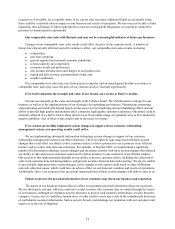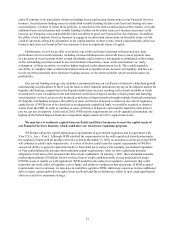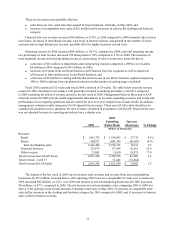Cabela's 2010 Annual Report Download - page 31
Download and view the complete annual report
Please find page 31 of the 2010 Cabela's annual report below. You can navigate through the pages in the report by either clicking on the pages listed below, or by using the keyword search tool below to find specific information within the annual report.21
and will continue to be particularly reliant on funding from securitization transactions for our Financial Services
business. Securitization funding sources include both variable funding facilities and fixed and floating rate term
securitizations. A failure to renew these facilities, to resecuritize the term securitizations as they mature, or to add
additional term securitizations and variable funding facilities on favorable terms as it becomes necessary could
increase our financing costs and potentially limit our ability to grow our Financial Services business. In addition,
the ability of our Financial Services business to engage in securitization transactions on favorable terms or at all
could be adversely affected by disruptions in the capital markets or other events, which could materially affect our
business and cause our Financial Services business to lose an important source of capital.
Furthermore, even if we are able to securitize our credit card loans consistent with past practice, poor
performance of our securitized loans, including increased delinquencies and credit losses, lower payment rates,
or a decrease in excess spreads below certain thresholds, could result in a downgrade or withdrawal of the ratings
on the outstanding securities issued in our securitization transactions, cause “early amortization” or “early
redemption” of these securities, or result in higher required credit enhancement levels. This could jeopardize
our ability to complete other securitization transactions on acceptable terms, decrease our liquidity, and force us
to rely on other potentially more expensive funding sources, to the extent available, which would decrease our
profitability.
Our current funding strategy also includes a continued reliance on certificates of deposit to help fund growth
and maturing securitizations. If there is an increase in other financial institutions relying on the deposits market for
liquidity and funding, competition in the deposits market may increase resulting in less funds available or funds
at unattractive rates. In addition to the non-brokered certificates of deposit market to fund growth and maturing
securitizations, we have access to the brokered certificates of deposit market through multiple financial institutions
for liquidity and funding purposes. Our ability to issue certificates of deposit is reliant on our current regulatory
capital levels. If WFB were to be classified as an adequately-capitalized bank, we would be required to obtain a
waiver from the FDIC in order to continue to issue certificates of deposits and would be limited to what interest
rate we can pay on deposits. At the end of 2010, WFB met the requirements for a well-capitalized institution, the
highest of the Federal Deposit Insurance Corporation Improvement Act’s five capital ratio levels.
We may have to reallocate capital from our Retail and Direct businesses to meet the capital needs of
our Financial Services business, which could alter our retail store expansion program.
WFB must satisfy the capital maintenance requirements of government regulators and its agreement with
Visa U.S.A., Inc. (“Visa”). Although WFB satisfied the requirements for the well-capitalized classification under
the regulatory framework for prompt corrective action at December 31, 2010, no assurances can be given that WFB
will continue to satisfy such requirements. A variety of factors could cause the capital requirements of WFB to
exceed our ability to generate capital internally or from third party sources. For example, government regulators
or Visa could unilaterally increase their minimum capital requirements. Also, we have significant potential
obligations in the form of the unused credit lines of our cardholders. At January 1, 2011, these unfunded amounts
totaled approximately $16 billion. Draws on these lines of credit could materially exceed predicted line usage.
If WFB ceases to qualify as well-capitalized, WFB would become subject to regulatory restrictions that could
materially adversely affect its liquidity, cost of funds, and ability to conduct normal operations. If WFB’s capital
requirements were to increase, we may have to contribute capital to WFB, which may require us to raise additional
debt or equity capital and/or divert capital from our Retail and Direct businesses, which in turn could significantly
alter our retail store expansion strategy.
























